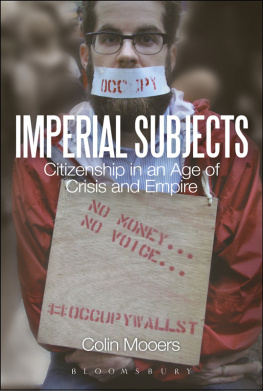Branding Latin America
Branding Latin America
Strategies, Aims, Resistance
Edited by Dunja Fehimovi and Rebecca Ogden
Foreword by Melissa Aronczyk
LEXINGTON BOOKS
Lanham Boulder New York London
Published by Lexington Books
An imprint of The Rowman & Littlefield Publishing Group, Inc.
4501 Forbes Boulevard, Suite 200, Lanham, Maryland 20706
www.rowman.com
Unit A, Whitacre Mews, 26-34 Stannary Street, London SE11 4AB
Copyright 2018 by The Rowman & Littlefield Publishing Group, Inc.
All rights reserved . No part of this book may be reproduced in any form or by any electronic or mechanical means, including information storage and retrieval systems, without written permission from the publisher, except by a reviewer who may quote passages in a review.
British Library Cataloguing in Publication Information Available
Library of Congress Cataloging-in-Publication Data Available
ISBN 978-1-4985-6827-2 (cloth : alk. paper)
ISBN 978-1-4985-6828-9 (electronic)
 The paper used in this publication meets the minimum requirements of American National Standard for Information SciencesPermanence of Paper for Printed Library Materials, ANSI/NISO Z39.48-1992.
The paper used in this publication meets the minimum requirements of American National Standard for Information SciencesPermanence of Paper for Printed Library Materials, ANSI/NISO Z39.48-1992.
Printed in the United States of America
Acknowledgments
This book has its origins in a conference entitled Branding Latin America, which took place at the University of Cambridge in April 2015, with the support of the Institute of Latin American Studies (ILAS), the Society of Latin American Studies (SLAS), and the University of Cambridge, School of Arts and Humanities.
Foreword
Melissa Aronczyk
The studies in this book show how material and symbolic relations across Latin America have conformed to, and in some cases resisted, the precepts of branding. Dunja Fehimovi and Rebecca Ogden have put together a compelling set of studies that is timely on many fronts. Their collaborators discuss the cultural and political underpinnings of collective narratives and the varied responses of Latin American residents. They examine the conditions under which domestic and foreign institutions produce media that shape perceptions of national image and reputation, and the attempts of institutions to manifest sources of global capital attraction aligned with these perceptions.
In the background, and central to the complexities faced by both modern Latin American institutions and the researchers here, are the economic and political crises in these regions starting in the 1970s and the shock doctrines that followed. In the last four decades, Latin American governments and their citizens have sought ways to reckon with the market-led reform initiatives imposed upon them. National brandingthe use of strategic tools, techniques, and expertise to create and communicate how national values and interests are attuned to footloose global capitalnormalized and further embedded political-economic aftershocks. If, here and elsewhere in the world, branding is the language of neoliberalism, it is not surprising that its effects are visible in sharp relief in the Latin American context.
Fehimovi and Ogden are concerned with the ways that national identities in Latin America are deliberately (re)defined according to the principle of competition and strategically (re)oriented towards the market. This concern is reflected in their contributorss chapters, who show how this redefinition takes place, whether historicized via world exhibitions (chapter 1), woven into film and music videos (chapters 2, 5, 7, 8), written intoor out oftourism guidebooks (chapter 3), contained in the conventions of journalism (chapter 6) or implanted into public displays of patriotism or values (chapters 4 and 9). As the editors explain, these are not only accounts of the cultural life of neoliberal nostrums; they are also windows onto the contemporary categories of identity, citizenship, and governance, and as such lead us onto wider analytical terrain.
The contributors to this book are sensitive to the pitfalls of applying the vernacular and practice of branding as a proxy for the pillars of the modern social imaginary. Nevertheless, growing professional and personal tendencies to characterize a wide range of activities as brandingthat is, the ways that self-conceptions, discursive practices, and models of sociability can all be labeled brandingdeserve scrutiny in their own right. Though these chapters identify problems specific to the country under investigation, they also point to global properties of branding that make it both powerful and pervasive, reflecting an overall moral confrontation.
The key to understanding the expansion of branding as a neoliberal genre is its flexibility. This is not surprising, as scholars have already noted the experimental, open-ended and plastic features of neoliberalization itself. Branding evokes a determinate set of possibilities for the constitution of identity. It can present an identity as a historical inevitability, perhaps aligned with nation building and economic development; or it can offer a narrative of national identity as a radical break with, and alternative to, dominant and/or foreign-imposed stereotypes. The strength of this book is that it does not foreclose on one or another mode of identity making. Instead, each chapter draws on empirical cases to offer evidence for the flexible uses to which branding is put. Moreover, the contributions to this collection recognize that both harmonious, all-in narratives of unity across stakeholders, and articulations of deviation from the mean, can be forms of symbolic violence in and of themselves. In the discipline of branding, neither parody nor affect constitute reliable countermeasures to the ultimate objective, which is to align national narratives and myths to the vagaries of the free market.
This is partly a problem of the platforms upon which brands and their discontents circulate. Brands are fundamentally media objects, and even the most determined forms of resistance to them typically assume their shape to meet them on common ground. At the outset this diminishes the effectiveness of resistant modes. Both narrative and counternarrative deploy the same strategies and appeal to audiences in the same ways, posing a challenge to users to distinguish between them. As some of the authors in this collection point out, this has important consequences for our conception of authenticity. It is not always clear whether the aim of branding identity is to make visible motives of political power or to highlight measures taken to counteract dominant forces. This has the unfortunate effect of diminishing a shared sense of legitimacy around national identifications and affiliations.
Another important contribution of this volume is to highlight the role of communication as a constitutive force in the repertoire of collective action. Branding campaigns are not merely a patina on the realer forces of material and institutional change; they are reality-producing agents in their own right. Contributors to this volume demonstrate the power of promotional narratives to influence, and even stand in for, policymaking, state diplomacy, and governance. Of course, contemporary media platforms also play a role here, promoting values of transparency and participation through communication even as they limit what is meant by these terms.
One reason we have turned to brands as forms of expression and identity is that they are understood as a disciplining force in dramatically undisciplined contexts of contemporary media and politics. Branding, for places and people as for products, is meant to create a coherent, unified, and simplistic narrative that positions its objects in space and time. Branding is nothing less than the management of affect and agency, rooted in business-based strategies meant to integrate culture and economy. That the techniques of branding have exceeded their origins in business to represent national self-understanding typifies attempts to order and control unruly populations.
Next page










 The paper used in this publication meets the minimum requirements of American National Standard for Information SciencesPermanence of Paper for Printed Library Materials, ANSI/NISO Z39.48-1992.
The paper used in this publication meets the minimum requirements of American National Standard for Information SciencesPermanence of Paper for Printed Library Materials, ANSI/NISO Z39.48-1992.